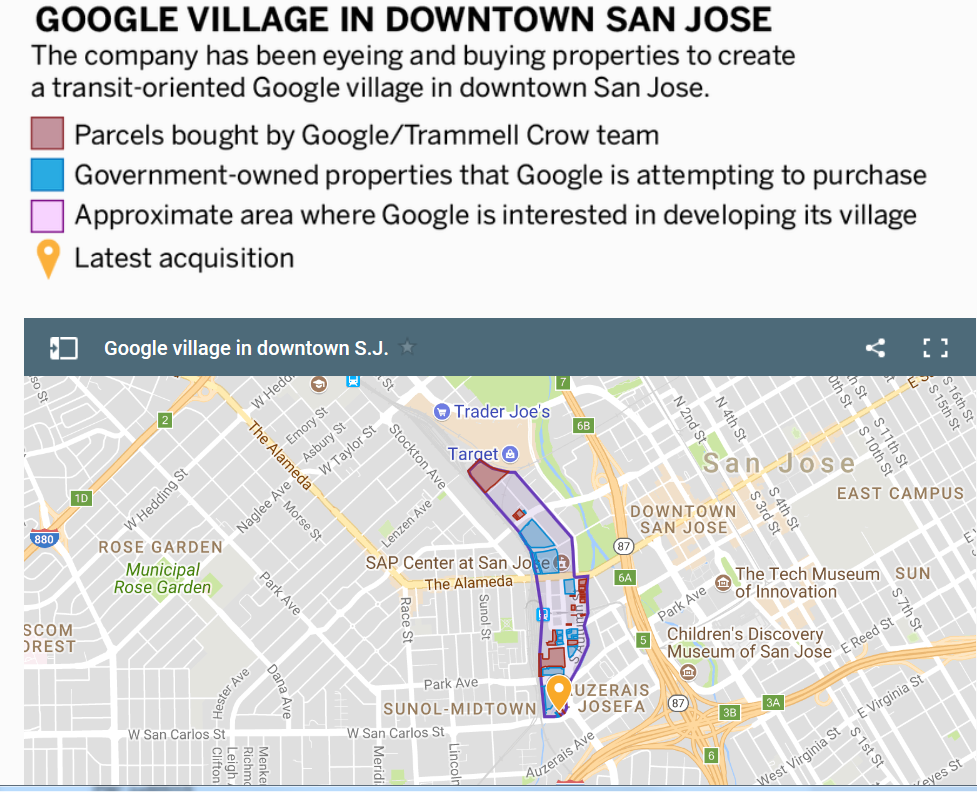Google’s downtown San Jose village “main” construction to start in 2025, property purchases continue
SAN JOSE — Construction of Google’s massive urban village in downtown San Jose is likely to begin about eight years from now, after BART and high-speed rail connections to Diridon Station are completed.
The time frame, outlined in a city memo, is the first public indication of how long it could be before construction starts on the tech giant’s expansion, which would bring up to 20,000 employees to downtown if the plan to reshape the core of San Jose moves forward.
Major construction and the “ultimate transformation” of the Diridon Station area is expected to occur from 2025-2027, according to the memo, written for San Jose’s City Council by Kim Walesh, San Jose’s director of economic development.
Meanwhile, Google’s development partner Trammell Crow continues to collect properties on the western edges of downtown, most recently with the Oct. 18 acquisition of a small parcel on West San Carlos Street near the train station.
Google and Trammell Crow-controlled affiliate TC Agoge are buying buildings and vacant parcels near Diridon Station and the SAP Center entertainment complex. They have already bought 20 parcels in the Diridon Station area, paying $146 million.
The $1.2 million purchase of the property at 695 W. San Carlos St. — a lot between South Montgomery Street and Los Gatos Creek that contains a small structure — demonstrates Google’s ongoing interest in pursuing the transit-village project.
Walesh’s memo suggests that Google’s negotiations to buy 16 government-owned properties at the heart of the proposed campus have encountered some delays, given the complexity of having multiple parties at the bargaining table.

“We have always represented that the development of the Diridon Station area was a long-term play,” Walesh said Monday. “What you are seeing now is an understanding that the area near the train station that Google is most interested in is going to be the construction and lay-down area for the BART station and an area of use and activity for the high-speed rail line. It’s very complex, and all of this needs to be tightly coordinated.”
The property-sale negotiations involve Google, city officials and representatives of Santa Clara County. Of the 16 parcels, seven are owned by the city of San Jose and nine are owned by the government entity linked to San Jose’s now defunct redevelopment agency.
“The complexities of determining the sale price with multiple agency owners and appraisers” means that the approval process for sale and development of the government properties is still in the early stages, the city memo states.
The delays have pushed back two key elements of the city’s efforts.
First, the city’s plan to engage and involve interested community groups, which was scheduled to get underway on Oct. 20, has been pushed back to just before Christmas.
In addition, the projected time frame to complete negotiations with Google for key elements such as agreed-upon sales prices for the government-owned properties also has been pushed back 60 days — until the end of May or early June 2018.
Despite the changes, all signs still suggest Google’s project is moving ahead, said Bob Staedler, a veteran observer of South Bay development and of downtown San Jose’s progress.
“This is the future, and it’s the transit-oriented development that companies need to have, with the current traffic situation in the Bay Area,” said Staedler, principal executive with Silicon Valley Synergy, a realty and land-use planning consultancy. “This is a legacy project for the city of San Jose. It’s going to happen.”
